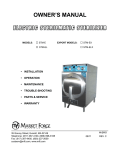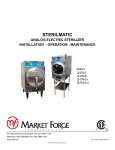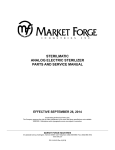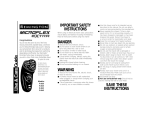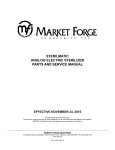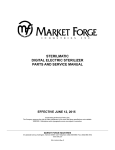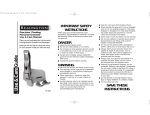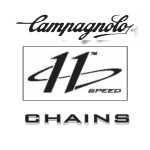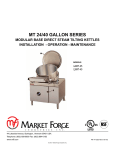Download Market Forge Industries STM-EX Operating instructions
Transcript
35 Garvey Street Everett, Massachusetts 02149 Tel: (617) 387-4100 or Toll Free: (866) 698-3188 Fax: (617) 387-4456 or (800) 227-2659 [email protected], www.mfii.com TABLE OF CONTENTS SECTION 1 INSTALLATION INSTRUCTIONS INSTALLATION ........................................................................................................................................................................... 2 ELECTRICAL .............................................................................................................................................................................. 2 OUTSIDE VENTING .................................................................................................................................................................... 2 WATER-COOLED EXHAUST CONDENSER .............................................................................................................................. 2 RECORDING THERMOMETER .................................................................................................................................................. 2 TRAY SUPPORTS ...................................................................................................................................................................... 3 BAFFLE INSTALLATION ............................................................................................................................................................ 3 OPERATION CHECK .................................................................................................................................................................. 3 INSTALLATION INSTRUCTIONS FOR COLD WATER CONDENSER ....................................................................................... 4 REQUIRED CONNECTIONS ...................................................................................................................................................... 5 INSTALLING PAN SUPPORTS AND BAFFLES ......................................................................................................................... 6 ELECTRICAL SUPPLY CONNECTIONS FOR STM-E AND STM-EL........................................................................................... 7 ELECTRICAL SUPPLY CONNECTIONS FOR STM-EX AND STM-ELX ..................................................................................... 7 DOMESTIC WIRE DIAGRAM FOR STM-E AND STM-EL ........................................................................................................... 8 DOMESTIC WIRE DIAGRAM FOR STM-EX AND STM-ELX ...................................................................................................... 9 TYPICAL CIRCUIT CONNECTION FOR STM-E AND STM-EL ...................................................................................................10 TYPICAL CIRCUIT CONNECTION FOR STM-EX AND STM-ELX EXPORT ............................................................................... 11 INSTALLATION FOR OPTIONAL RECORDING THERMOMETER ............................................................................................. 12 TO REMOVE THE CHART ..........................................................................................................................................................12 TO INSTALL NEW CHART .........................................................................................................................................................12 PEN ADJUSTMENT .................................................................................................................................................................... 12 REPLACEMENT PARTS FOR 24 HOUR THERMOMETER ........................................................................................................ 12 SECTION 2 WATER CONDITIONS ............................................................................................................................................13 SECTION 3 OPERATING INSTRUCTIONS OPERATING INSTRUCTIONS ....................................................................................................................................................14 STERILIZATION GUIDE ............................................................................................................................................................. 15 MINIMUM STERILIZATION TIMES .............................................................................................................................................16 SECTION 4 DAILY CLEANING DAILY CLEANING PROCEDURE ............................................................................................................................................... 16 SECTION 5 ASSEMBLY STERILMATIC OPEN STAND .....................................................................................................................................................17 STERILMATIC OPEN STAND WITH CONDENSER ...................................................................................................................17 PARTS LIST FOR CONDENSER WITH OPTIONAL STAND ......................................................................................................17 STERILMATIC DOOR ASSEMBLY .............................................................................................................................................17 DOOR ADJUSTMENT .................................................................................................................................................................18 THE DOOR GASKET ..................................................................................................................................................................18 DOOR LIFT SPRING ...................................................................................................................................................................18 TO REMOVE THE DOOR ASSEMBLY .......................................................................................................................................19 DOOR ASSEMBLY PARTS LIST ................................................................................................................................................19 THE FULCRUM AND DRAIN ASSEMBLY ..................................................................................................................................20 FULCRUM AND DRAIN PARTS LIST .........................................................................................................................................20 ROLLER ASSEMBLY ..................................................................................................................................................................21 DOMESTIC – THE PRESSURE ACTUATED TEMPERATURE CONTROL, STM-E AND STM-EL .............................................21 DOMESTIC – HOW IT WORKS .................................................................................................................................................. 21 DOMESTIC – ADJUSTING THE RANGE OR OPERATION, STM-E ...........................................................................................21 EXPORT - THE PRESSURE ACTUATED TEMPERATURE CONTROL, STM-EX AND STM-ELX .............................................22 EXPORT – HOW IT WORKS ...................................................................................................................................................... 22 EXPORT – CHECKING THE 100 oC SETTING, STM-ELX ........................................................................................................... 22 EXPORT – ADJUSTING THE RANGE OF OPERATION, STM-ELX ...........................................................................................22 DOMESTIC – CHECKING THE 230o SETTING, STM-EL ........................................................................................................... 23 DOMESTIC – ADJUSTING THE RANGE OF OPERATION, STM-EL .........................................................................................23 CAST-IN THE HEATING ELEMENTS .........................................................................................................................................23 THE LOW WATER CUT-OFF (MANUAL RESET) .......................................................................................................................23 THE ELECTRIC CONTACTORS .................................................................................................................................................23 THE TIMER .................................................................................................................................................................................24 THE STEAM PRESSURE GAUGE ..............................................................................................................................................24 THE SAFETY VALVE ..................................................................................................................................................................24 THE FLUE ...................................................................................................................................................................................24 THE EXHAUST SOLENOID VALVE ............................................................................................................................................24 TO REPLACE A THERMOSTATIC ELEMENT ............................................................................................................................25 THE STEAM TRAP .....................................................................................................................................................................25 HOW IT WORKS .........................................................................................................................................................................25 SECTION 6 ILLUSTRATED PARTS MASTER ILLUSTRATION AND PARTS, STM-E AND STM-EX .......................................................................................... 26 & 27 MASTER ILLUSTRATION AND PARTS, STM-El AND STM-ElX ......................................................................................... 28 & 29 CONTROL CONSOLE PARTS LIST FOR STM-E AND STM-EX .................................................................................................30 CONTROL CONSOLE PARTS LIST FOR STM-EL AND STM_ELX............................................................................................. 31 DOOR HANDLE PARTS LIST .....................................................................................................................................................32 SECTION 7 TROUBLE SHOOTING STEAM TRAP TROUBLE-SHOOTING ........................................................................................................................................ 33 TROUBLE-SHOOTING GUIDE ...................................................................................................................................................34 SECTION 8 WARRANTY INFORMATION ..................................................................................................................................36 1 SECTION 1 INSTALLATION INSTRUCTIONS AUTOMATIC STERILMATIC STEAM PRESSURE STERILIZER MODELS: STM-E, STM-EL, STM-EX & STM-ELX Your Sterilmatic Sterilizer has been developed to answer the need for a compact, automatic, low-cost steam pressure sterilizer. The following instructions cover installation. Should service be required, it is readily available by contacting our authorized service agency located nearest to you. The name of your local service company can be obtained by contacting the Service Department at Market Forge Co., 35 Garvey Street, Everett, MA 02149, Tel. (617) 387-4100 or via our web site www.mfii.com. INSTALLATION Set sterilizer on counter, using the 4" (102mm) legs provided or assemble the optional stainless steel stand with under-shelf. If your Sterilmatic includes a water-cooled exhaust condenser, we recommend the use of the Sterilmatic stand, part number 95-6060. First, level unit in place, then adjust rear legs to pitch the unit forward 1/4" (6mm) to insure positive drainage of the cylinder. ELECTRICAL Connect to proper electrical supply box and disconnect switch as shown on one of the following schematic diagrams-208 or 240 volts, single or three phase. Connection is located behind the terminal box cover at the lower left side of unit. Whether the supply current is 208 volt or 240 volt, single or three phase, all control circuits are 120 volts. In order to accomplish this connection, a current-carrying grounded neutral must be provided. Thus, a three phase system must be 4-wires and a single phase system must be 3-wires. If a current-carrying grounded neutral is not available from the power source, a separate 120 volt circuit must be run. Most electrical codes require, and we recommend, that a separate disconnect switch be located within sight of the sterilizer. When separate 120 volt control circuit must be run, this must also be part of the disconnect box assembly. OUTSIDE VENTING Connect 1/2" (13mm) nominal tubing exhaust to outside vent connection located on the top of the control housing. IMPORTANT: Exhaust line must be vented to the outside to eliminate the exhausted steam and the accompanying noise from entering the room. Use 1/2" (13mm) copper tubing or suitable alternate. Length of the line should not exceed 15 feet (4.5 meters) and should have a minimum of bends. The line should slope downward after leaving the sterilizer in order to insure condensate drainage. WATER-COOLED EXHAUST CONDENSER If outside venting is not possible, an optional water-cooled condenser is available for connection to an open drain. If required order part number 95-0436 kit. RECORDING THERMOMETER If a recording thermometer is provided, refer to installation guide provided with recorder. 2 SECTION 1 INSTALLATION INSTRUCTIONS TRAY SUPPORTS Install side tray supports. Tray supports are attached by means of key-hole clearance slots which are slipped over studs located on the sides of the Sterilmatic chamber. BAFFLE INSTALLATION To insure maximum drying of packs, a baffle is supplied with your STM-E Sterilmatic. Place perforated splash baffle in bottom of the sterilizing chamber. Install small baffle with no perforation at the rear of the upper tray support channel. OPERATION CHECK To check for proper operation of unit: 1. Close drain valve by turning handle clockwise. WARNING: DO NOT OPEN DRAIN VALVE WHILE UNIT IS OPERATING. PREMATURE OPENING MAY RESULT IN SCALDING OF OPERATOR. 2. Fill chamber with 4 to 6 quarts (3.7 to 5.6 liters) of ordinary tap water. DO NOT USE DISTILLED OR DIONIZED WATER. 3. Close chamber door. 4. Set exhaust selector to INSTRUMENTS AND PACKS (fast exhaust) or LIQUIDS (slow exhaust). 5. Set timer to 15 minutes. Cycle will go to completion automatically. NOTE: Cycle timer will not start until sterilizing temperature is obtained. 3 SECTION 1 INSTALLATION INSTRUCTIONS 4 SECTION 1 INSTALLATION INSTRUCTIONS 5 SECTION 1 INSTALLATION INSTRUCTIONS INSTRUCTIONS FOR INSTALLING PAN SUPPORTS AND BAFFLES 1. Locate the mounting studs on the inside of the chamber. There are two rack mounting studs on each side. 2. Taking one pan support and positioning rack so that the pan stop is facing the rear of the unit and the wires are facing toward the center of the unit. The pan stop is a piece of sheet metal welded to the rack with a 65o bend. 3. Begin to hang the pan support by placing the rear key-way slot onto the rear mounting stud and slide the rack until the slot sits on the mounting stud. When this is done correctly the front mounting stud will be in position to place the front key-way slot. Slide the rack down into its correct position. See Fig. 1 . Fig. 1. 4. After installing one pan support rack correctly, you can install the baffle. Position the baffle so that the 45o bend is facing up and towards the front of the unit. Slide the mounting tab onto the flat bend on the pan stop bracket. The baffle should now stay in place by itself, but in a tilted state. See Fig. 2. Fig. 2. 5. Position the second pan support rack into the cavity and slide the other mounting tab onto the rack flat bend while the pan support rack is not on the mounting studs. Hang the pan support by placing the rear key-way slot onto the rear mounting stud and slide the rack until the slot sits on the mounting stud. When this is done correctly the front mounting stud will be in position to place the front key-way slot. Slide the rack down into its correct position. See Fig. 3. Fig. 3. 6 SECTION 1 INSTALLATION INSTRUCTIONS THE ELECTRIC SUPPLY CONNECTIONS FOR STM-E AND STM-EL Connect to proper electrical supply as indicated on nameplate on top of unit. Connection is located behind the terminal box cover at the lower left side of unit. Whether the supply current is 208 or 240 volt, single phase or three phase, all control circuits are 120 volts. In order to accomplish this, a current-carrying grounded neutral must be provided. Thus, a three phase system must be 4-wires and a single phase system must be 3-wires. If a currentcarrying grounded neutral is not available from the power source, a separate 120 volt circuit must be run. Most electrical codes require, and we recommend, that a separate disconnect switch be located within sight of the sterilizer. When a separate 120 volt control circuit must be run, this must also be part of the disconnect box assembly. THE ELECTRIC SUPPLY CONNECTIONS FOR STM-EX AND STM-ELX EXPORT Connect to proper electrical supply as indicated on nameplate on top of unit. Connection is located behind the terminal box cover at the lower left side of the unit. All control circuits are 220 volts. In order to accomplish this, a current-carrying grounded neutral must be provided. Thus, a three phase system must be 4-wires. Most electrical codes require, and we recommend, that a separate switch be located within sight of the sterilizer. 7 SECTION 1 INSTALLATION INSTRUCTIONS 8 SECTION 1 INSTALLATION INSTRUCTIONS 9 SECTION 1 INSTALLATION INSTRUCTIONS TYPICAL CIRCUIT CONNECTION FOR STM-E AND STM-EL 10 SECTION 1 INSTALLATION INSTRUCTIONS TYPICAL CIRCUIT CONNECTION FOR STM-EX AND STM-ELX EXPORT MODELS 11 SECTION 1 INSTALLATION INSTRUCTIONS INSTALLATION FOR OPTIONAL RECORDING THERMOMETER The Optional Recording Thermometer may be surface or panel mounted as best accommodates the layout of the sterilization area. 1. Remove the top cover. Remove the pipe plug located in the T-fitting that also accommodates the safety relief valve and which is connected directly to the sterilizing chamber. 2. Insert the thermometer bulb of the temperature recorder into the pipe, from which the plug was removed. 3. Tighten the fittings. Bend that portion of the Thermometer bulb coil that extends inside the shell toward the rear of the cylinder and at an angle of 45° so that it does not interfere with mounting the overhead baffle plate (Item #20 Master Illustration). 4. For mounting the recorder on a wall or on the unit itself, the 3/16" diameter tapped holes in the angles which are attached to the recorder must be drilled out. This allows for the use of wood or sheet metal screws on walls or panels, and nuts and bolts on the unit itself.* 5A. Electrical connections to the recorder are made by running a line from the recorder to any 120 volt supply. Connection can also be made at the supply connection for the unit by utilizing the proper wires to gain 120 volts. Connect either L 1, L2, or L3 for power lead (black wire and the neutral white wire) line for the other side of the 120 volt line. 5B. Electrical connections to the recorder are made by running a line from the recorder to any 220 volt supply. Connection can also be made at the supply connection for the unit by utilizing the proper wires to gain 220 volts. Connect either L 1, l2, L3 for power lead (black wire and the neutral white wire) line for the other side of the 220 volt line. 6. The United Electric Recording Thermometer is a 24 hour clock and should be run continuously. Charts should be changed every 24 hours. "For further mounting instructions. see the Manufacturers Instruction and Maintenance Instructions, Form #17-0099." TO REMOVE THE CHART 1. Unscrew and remove the chart knob and lift the pen by depressing the pen lifter. 2. Grasp edge of the chart, lift off the chart hub and slide downward and out without permitting the paper to touch the pen. TO INSTALL NEW CHART 1. Slide edge of the chart under the pen and over the hub, insert the upper edge under the nameplate chart guide and seat the chart hole on the hub. 2. Set correct chart time to the chart plate time index line and replace the knob. PEN ADJUSTMENT - If the pen point is not aligned properly with the temperature to be recorded (as checked by an ordinary thermometer), it may be corrected in the following manner: 1. Locate the small fillister head screw on the right side of the extreme upper end of the Pen Assembly. 2. Turn the screw clockwise for pen movement toward the hub (or counter-clockwise for pen movement away from the hub) until the temperature value of the ink line has been adjusted to its proper position. PART NO. PART NO. 10-7933 08-6244 REPLACEMENT 24 HOUR THERMOMETER CHART FAHRENHEIT REPLACEMENT 24 HOUR THERMOMETER CHART CELSIUS 12 SECTION 2 WATER CONDITIONS Market Forge from time to time is asked the question about using distilled or dionized water for use with our Sterilizer models STM-E and STM-EL. We are always asked why these water choices are not allowed for use with our units and what would be recommended. To address this situation, we have complied the following as a means of satisfying these questions: 1. We have found that the use of distilled or dionized water will aggressively attack the pure coat of Aluminum Alclad, which protects the bottom surface from oxidizing and then eventually pitting (reference: Operating and Maintenance Instructions). 2. In addition pitting can also be caused by several other external environmental factors. Few examples are as follows. These conditions have been highlighted in our documentation. Grains of hardness in the water supply should be as follows (.25 to 2). a pH imbalance in the water supply can greatly affect the life to the aluminum cylinder. The pH range that would be recommended is between 7.0-8.5. The lack of a positive electrical ground can cause an electrolytic reaction that will accelerate pitting. Another contribution to accelerate pitting is the type of cleaning solutions used or the abrasive scrubbing pads. If a low pH is present with the detergents being used or an abrasive pad, the protective Alclad coating will be removed during the cleaning process. Spillage of media being sterilized can also contribute to the accelerated pitting if it is corrosive. CHLORINE LEVEL 1 PPM. IMPORTANT NOTE: Market Forge will not be responsible for damage resulting from the use of hard or corrosive water, from failure to drain the unit daily, or from inadequate cleaning procedures. 13 SECTION 3 OPERATING INSTRUCTIONS OPERATING INSTRUCTIONS: 1. IMPORTANT: Make sure the drain valve is closed. Fill bottom of the sterilizer chamber with approximately six quarts of water or just bellow ledge at bottom of door opening. (If water supply is known to be hard or corrosive, a source of treated water should be used.) DO NOT USE DISTILLED OR DIONIZED WATER. (See page 13) 2. LOAD STERILIZER: Use proper sterilizer loading procedures when placing materials in sterilizer chamber. All solid containers or instruments must be placed so that water or air will not be trapped in them. 3. CLOSE DOOR: Grasp handle, and holding it in vertical position, pull door down until bottom of door rests in the bottom of door opening. Then rotate handle forward, engaging the lower curved portion under the horizontal rod in the casting at the bottom of the door opening. Push handle all the way down and back until door is locked securely in position. 4. SET EXHAUST SELECTOR: Located at center of the control housing mounted on top of the unit, to correct position. Unit is now ready to start. All items, other than solutions, may be sterilized with selector at "Instruments". Solutions require a low exhaust. Place selector at "Liquids". 5. DETERMINE CORRECT STERILIZATION TIMES: (Referring to pages 15 & 16 for minimum required times in the sterilization guide and times table.) NOTE: In no case should the timer be set to less than 15 minutes. Sterilization will not be accomplished in less than 15 minutes exposure time. 6. TURN TIMER: Located at upper right front of sterilizer. Select desired length of sterilizing period. This turns power supply on and starts the cycle after pressuretemperature combination has been reached. Amber pilot light indicates that the timer is running. 7. When the sterilizer chamber reaches the selected temperature, the timed exposure cycle will begin. When the exposure cycle is completed, the electric supply will be opened automatically. When the chamber pressure gauge located at the top of the control housing reads "0", the door may be opened. (Release handle and let go to avoid possible contact with remaining steam.) When opening the door, allow a few seconds for steam to escape from chamber before opening completely. 8. To assist in drying racks, release door handle after pressure has been attained at start of cycle. Pressure in chamber will keep door closed. The use of a wire basket will provide better drying for dressings. At end of sterilizing cycle, release door handle and open slightly. Do not lift door to open position. This will allow steam and moisture to escape. Allow door to remain in this position for 15 to 20 minutes before removing load. Small packs can be dried successfully with this procedure. We do not recommend the sterilization of large packs, such as linens. Be sure condensate baffles are in position in the chamber. 14 9. Remove load and check water level for next operation. SECTION 3 OPERATING INSTRUCTIONS STERILIZATION GUIDE PACKS (Linens, gloves, etc.) – Use wire basket to facilitate drying. Be sure condensate baffles are in place. Place packs on edge and arrange load in chamber, so that only minimal resistant to passage of steam through the load will exist. NOTE: Place gloves in upper twothirds of chamber. JARS, CANISTERS (etc.) – Place containers on side to allow for displacement of air and complete contact of steam to surfaces. Drying is also facilitated. PETRI DISHES, PIPETTES, DESICCATORS (etc.) – Should be inverted. UTENSILS, TREATMENT TRAYS – Placed on edges to facilitate drying. INSTRUMENT SETS – Place instruments set in trays having mesh or perforated bottoms. Place trays flat on shelves. COMBINING FABRICS & HARD GOODS – Place hard goods on lowest shelves. PLASTIC UTENSILS – DO NOT stack or nest plastic items. LIQUIDS – Sterilize medium liquids separately from other supplies or materials. Set exhaust selector to proper position (liquids). SMALL ITEMS – Sterilize small items in baskets, or trays. 15 SECTION 3 OPERATING INSTRUCTIONS MINIMUM STERILIZATION TIMES TIME (Minutes) 15 20 30 45 ARTICLES - Glassware, empty, inverted. - Instruments, metal in covered or open tray, padded or unpadded. - Needles, unwrapped. - Pipettes, blood diluting, serological, volumetric, etc - Tubing glass (6mm), (10mm) inverted - Flasked solutions 75-250 mo. - Instruments, metal combined with other materials in covered and/or padded tray. - Instruments wrapped in double thickness muslin. - Rubber gloves, catheters, drains, tubing, etc. Unwrapped or wrapped in muslin or paper. - Brushes in dispensers, in cans of individually wrapped. - Dressings, wrapped in paper or muslin, small packs only. - Flasked solutions 500-1000 ml. - Needles, luer, individually packaged in glass tubes or paper. - Syringes, unassembled, individually packaged in muslin or paper. - Flasked solutions 1500-2000 ml. SECTION 4 DAILY CLEANING DAILY CLEANING PROCEDURE: (AT THE END OF THE DAY) a. Remove bottom splash baffle NOTE: IMPORTANT! STERILIZING CHAMBER MUST BE CLEANED AND DRAINED DAILY USING THE FOLLOWING PROCEDURE. WASH WETTED PORTION OF THE CYLINDER THOROUGHLY BY ADDING A MILD DETERGENT TO WATER IN CYLINDER. b. If a soft cloth or brush is used with the detergent and does not completely remove the surface film, a nylon soap pad should be used. After washing thoroughly rinse with clean water. Dry cylinder* and leave door open overnight. * The Sterilmatic cylinder is constructed of corrosion resistant Alclad aluminum alloy. The protective properties of this material afforded to the interior portion of the cylinder which is exposed to water may be destroyed by allowing a film to form. Such a film can be caused by salts or other contaminants in the water. Corrosion may also occur if water is not drained daily. 16 SECTION 5 ASSEMBLY STERILMATIC OPEN STAND Market Forge Sterilmatic Stand can be supplemented with an Optional Stand for utility use where maximum compactness is desired. The sturdy, stainless steel unit is equipped with adjustable leg extensions which allow the unit to be installed and leveled over existing contours in the floor . The open design lends itself to maximum sanitary conditions because of the ease with which periodic cleaning can be done. Though simple in design and appearance, the sterilmatic stand is the ideal arrangement for mounting in that it allows secondary air to circulate STERILMATIC OPEN STAND WITH CONDENSER Market Forge can provide the open stand with an optional steam condenser system for use where steam exhaustion into the room is undesirable. The condenser is automatically controlled by the thermostat. The normal factory thermostat setting is 130° (54° C). The open under-shelf of the stand gives added utility. providing a handy tabouret for utensils and access for drainage of water from the sterilizing chamber. ITEM 1 2 3 4 5 PARTS LIST FOR CONDENSER WITH OPTIONAL STAND PART NO. 50 Hz DESCRIPTION 10-4653 10-4653 Thermostat 10-4035 10-7074 3/8" Solenoid 10-5731 10-5731 1/2" Water Stop Valve 95-2106 95-2106 Water Injection Assembly 95-1680 95-1680 Shelf STERILMATIC DOOR ASSEMBLY The Door of the Sterilmatic has been engineered to establish a positive method of sealing the steam pressure within the sterilizing cylinder. As steam pressure builds up within the cylinder, the door seal will tend to become more positive. However, the door should be adjusted to make a good initial seal between the door gasket and the door opening without the added assistance of internal cylinder steam pressure with the simple action of securing the door handle down in a locked position, the door gasket should be sufficiently compressed against the door opening, all the way around to prevent any steam leakage from occurring. 17 SECTION 5 ASSEMBLY DOOR ADJUSTMENT The Door Adjustment is Located in the Fulcrum Casting at the base of the door opening. This adjustment employs the use of a screw and locknut In order to adjust the Sterilmatic Door to a tighter closed position (to prevent steam from leaking by the door gasket as pressure builds up), it is necessary to loosen the locknut and back off the screw at least one-quarter of a turn and re- tighten the locknut. THE DOOR GASKET Keep the gasket clean. With normal closing and locking of the door assembly, a steam-tight seal should be made between the door gasket and the door opening. This seal cannot be maintained if particles of foreign matter are allowed to accumulate upon either of the contacting surfaces. If there is leakage by the door gasket before a steam build-up within the cooking chamber causes it to stop, regard the door assembly as improperly adjusted. A re-adjustment must then be made of the seal adjustment door screw. To change the door gasket, remove the entire door assembly as a unit. Discard the old gasket, replace it with a new one (no cement is required), and reinstall the door assembly. Make an operational check for leakage and adjust the door, if necessary. DOOR LIFT SPRING Market Forge supplies door lift springs in sets only. This policy has been found to be in the best interest of the customer. Through continuous use, some of the original qualities of the springs are lost and it becomes advantageous to make replacements to both the left and right door lift springs in the event that one becomes damaged or broken. Replacement door lift springs are marked with tabs at the factory prior to shipment to identify a right from a left spring. These springs must be installed with the right door lift spring on the right of the door and the left door lift spring on the left of the door as viewed from the front of the sterilizer. 18 SECTION 5 ASSEMBLY TO REMOVE THE DOOR ASSEMBLY The Door Assembly can be removed from the inner sterilizing chamber as a unit without the use of any special tools or equipment. However, a systematic approach to this is warranted as the clearances through the portal are close, and much confusion can result if not removed in the sequence described below: 1. First, lift off and remove the two pan supports to expose the door linkage on either side of the inner sterilizing chamber . 2. Raise the door to a fully opened position, and disengage the door spring from each of the door spring studs. Accomplish this by counteracting the force of the door lift spring with one hand while working the end of the door spring off the spring stud with the free hand. Do this on both sides of the door assembly. 3. When the end of the door springs have been completely freed from their respective door spring studs, the door springs on either side of the door assembly can easily be slipped off their studs. 4. Rotate the entire door assembly out through the door opening, passing the door handle through the opening first, and then one end of the door spring as shown in the illustration. The remainder of the door assembly will then pass through the door opening quite easily. 5. To replace the door assembly, reverse the step-by-step procedure described above. ITEM 1 2 3 4 5 PART NO. 10-6765 91-2718 10-1776 10-2666 95-3204 95-0124 DESCRIPTION Pivot Spring Bearing Right and Left Door Spring (sold as a pair) 10-32 Machine Screw 1/2" Long Door Gasket Door & Door Spring Assembly ITEMS 1 THROUGH 6 19 SECTION 5 ASSEMBLY THE FULCRUM & DRAIN ASSEMBLY The fulcrum and drain assembly is located at the lower front of the sterilizing chamber and furnishes a sturdy anchorage for the door locking system of the door handle. Also provided in this assembly is a means for adjustment of the door seal. The drain port and drain valve provide a means of discharging accumulations of water from within the sterilizing chamber. 20 SECTION 5 ASSEMBLY ROLLER ASSEMBLY (Items 8 & 9) The Roller Assembly must be kept free-rolling at all times. Should this assembly be allowed to become frozen due to lack of lubrication, undue strain will be put on the door handle and the fulcrum casting while the door is being locked. Use only a dry lubricant such as graphite; as oil or grease will tend to attract dirt to this area. DOMESTIC THE PRESSURE ACTUATED TEMPERATURE CONTROL, STM-E AND STM-EL The pressure actuated temperature control, located behind the control panel assembly, governs the manufacture of steam by controlling the input of electric current to the heating elements. HOW IT WORKS When the Timer is set, rear and front contactors will become energized allowing input of current to the temperature control, thus closing the contacts completing the current to the heating elements. Steam will then be generated within the sterilizing chamber. The steam pressure within the sterilizing chamber is transmitted by means of a tube to the bellows of the temperature control; as the steam pressure increases, its compression action on the bellows causes the Switch #1 on the control is set to cut out on rising pressure at 13.5 PSI and to cut in on falling pressure at 13 PSI. (controlling the two outer banks of heating elements}. Switch #2 is set to cut out on rising pressure at 15.5 PSI. and cut in on falling pressure at approximately 15 PSI (controlling center heater element only}. Thus, a balancing effect of steam pressure build-up and heater element current is constantly maintained during the sterilizing cycle. When the Timer signifies the end of the cycle, the electric current to the contactors will automatically be broken; the temperature control contacts will be broken; and steam generation will stop. ADJUSTING THE RANGE OF OPERATION, STM-E The operational range of the temperature control is factory set as follows: Outer bank of elements OFF at 13.0- 13.5 PSI; Center bank of elements OFF at 15.5- 15.0 PSI; minor compensating adjustments can be made by turning the adjusting screws counter-clockwise to increase pressure and clockwise to decrease pressure. Both screws should be turned the same amount when making an adjustment. NOTE: When resetting this control for elevations above sea Level a correction of 6/10 Ib. per thousand feet is necessary. 1. Before making adjustments, shut all electrical current to the sterilizer OFF to eliminate shock hazard. 2. Remove the Flue Cover. 3. Make sure that all exposed wires are not in a hazardous position, and then turn on electrical power. 4. Run unit through cycle, observing pressure and temperature gauges, turn adjusting screws as required 21 SECTION 5 ASSEMBLY EXPORT THE PRESSURE ACTUATED TEMPERATURE CONTROL, STM-EX AND STM-ELX The pressure actuated temperature control, located behind the control panel assembly, governs the manufacture of steam by controlling the input of electric current to the heating elements. HOW IT WORKS When the timer is set, rear and front contactors will become energized allowing input of current to the temperature control, thus closing the contacts completing the current to the heating elements. Steam will then be generated within the sterilizing chamber. The steam pressure within the sterilizing chamber is transmitted by means of a tube to the bellows of the temperature control; as the steam pressure increases, its compression action on the bellows causes the contacts to make or break according to the condition of the pressure at that time (rising or falling). Switch #1 on the control is set to cut out on rising pressure at 0.89 kg/cm2 and to cut in on falling pressure at 0.84 kg/cm2 (controlling the two outer banks of heating elements). Switch #2 is set to cut out on rising pressure at 0.89 kg/cm2 and cut in on falling pressure at approximately 1.05 kg/cm2 (controlling center heater element only) . Thus, a balancing effect of steam pressure build-up and heater element current is constantly maintained during the sterilizing cycle. When the Timer signifies the end of the cycle, the electric current to the contactors will automatically be broken. CHECKING THE 110°C. SETTING, STM-ELX The Unit should be completely evacuated then temperature selector dial turned to 110o C Centigrade. Observe the current until it takes a sharp drop to approximately one-third of the full load; at this instant, there should be a corresponding chamber pressure of 0.14 kg/cm2. Observing the current further will show another sharp drop to approximately 1 Amp; at this instant, there should be corresponding chamber pressure of 0.43 kg/cm2 and a temperature reading of 110°C Centigrade, on the temperature gauge. ADJUSTING THE RANGE OF OPERATION, STM-ELX The range of operation of Model STM-ELX is adjusted by simply turning the adjusting knob on the outside of the Control Panel. A counterclockwise turn decreases the pressure while a clockwise turn increases the pressure. Observe pressure and temperature gauges and adjust knob as required. NOTE: When resetting this control for elevations above 2 sea level, a correction of 0.13 kg/cm per kilometer elevation is necessary. 22 DOMESTIC SECTION 5 ASSEMBLY CHECKING THE 230° SETTING, STM-EL The Unit should be completely evacuated then temperature selector dial should be turned on 230° Fahrenheit, Observe the current until it takes a sharp drop to approximately one-third of the full load; at this instant, there should be a corresponding chamber pressure of 2 PSI Observing the current further will show an- other sharp drop to approximately 2 Amps; at this instant, there should be a corresponding chamber pressure of 6.1 PSI and a temperature reading of 228° to 232° Fahrenheit, on the temperature gauge. ADJUSTING THE RANGE OF OPERATION, STM-EL The range of operation of Model STM-EL is adjusted by simply turning the adjusting knob on the outside of the Control Panel. A counter-clockwise turn decreases the pressure while a clockwise turn increases the pressure. Observe pressure and temperature gauges and adjust knob as required. NOTE: When resetting this control for elevations above sea level, a correction of 6/10 Ibs. per thousand feet is necessary. CAST-IN HEATING ELEMENTS Located under the sterilizing cylinder is a bank of (3) U-shaped heating elements. These elements are welded in place in a protective aluminum shield. The elements cannot be removed, and in the unlikely event that one or all fail, the complete cylinder must be replaced. THE LOW WATER CUT -OFF (MANUAL RESET) Fastened to a special mounting brace behind the front panel, the Low Water Cut-Off acts to shut off the complete unit, should the water run dry. The Low Water Cut Off is factory set, to shut the unit off when the cylinder temperature rises between 380o and 440° Fahrenheit. When the Sterilmatic is turned on without water or the water has been evaporated away, the temperature of the aluminum sterilizing cylinder will rise and by heat induction effect the Low Water Cut-Off. Its inner electrical contacts will be forced open from heat expansion, thus cutting off the flow of electric current to the heating elements. With the replacement of water into the cylinder. The cylinder temperature will drop and the contacts of the Low Water CutOff can be again closed. The unit will only restart after the manual button has been re-set. THE ELECTRIC CONTACTORS The Electric Contactors are located behind the removable lower front panel. These important components receive an electrical impulse when the Timer is turned on. When the unit reaches a pre-set pressure of 13-13.5 PSI the #1 switch will cut out causing the front contactor to become de-energized. This, in turn, will disconnect the left and right bank of heaters and the timer motor will start. 23 SECTION 5 ASSEMBLY THE TIMER The Sterilmatic is put into operation with the manual setting of the timer. With the setting of the timer, an electrical current is directed to the pressure control. The current energizes the pressure control, which activates the contactor coils to cause a current flow to the heating elements. When the cylinder pressure reaches 13 to 13.5 PSI, the timer motor and pilot light are energized. At the end of the cycle the timer will cut off the flow of electricity to all the components except the exhaust, the exhaust solenoid and the timer motor. They will revert back to their original deactivated state. The timer motor and pilot light will continue to be energized after the timed sterilizer cycle has been completed and for two additional minutes. Only after this will the timer and white pilot light is de-energized. If the timer fails to operate the Sterilmatic, replace it. The timer is replaceable only as a complete unit as factory repairs to it would not be practical in the economical interests of the customer. THE STEAM PRESSURE GAUGE The Steam Pressure Gauge registers the pressure of steam, which is within the sterilmatic sterilizing chamber. To replace this unit, it is necessary to disconnect the copper tubing and to remove the two nuts holding the gauge framework in place THE SAFETY VALVE The Safety Valve is factory set to automatically open and exhaust excess steam from within the sterilizing cylinder, thereby assuring that operating pressures remain within safe limits. The lever action of the safety valve must be free to operate unrestricted at all times. If the Safety Valve should leak continually with a pressure build-up or should it cause an interruption on a sterilizing cycle prematurely (below 124° Centigrade on the temperature gauge), it must be re- placed. However, the temperature gauge should first be checked for accuracy. THE FLUE The Flue serves as a protective shield for the steam trap safety valve, exhaust valve, as well as a mounting base for the control panel. The pressure gauge, dial thermometer, exhaust valve switch and timer, protrude through the control panel. The Flue cover may be removed to allow more room for servicing the control components. The control panel face may then be removed by unscrewing the sheet metal screws, which mount it to the Flue. THE EXHAUST SOLENOID VALVE The exhaust solenoid is normally closed and only opens at the end of the cycle when it is energized. 24 SECTION 5 ASSEMBLY TO REPLACE A THERMOSTATIC ELEMENT 1. Remove the cap of the steam trap (turn it counter-clockwise). 2. Unscrew the diaphragm and seat and discard. 3. Wipe all dirt and scale from the inside of the steam trap. 4. Place a new diaphragm and seat securely into the stea trap and replace the cap (New Style - Part No. 98-1719). THE STEAM TRAP The Steam Trap has the very important automatic, dual function of exhausting all air from the sterilizing compartment, and of making a suitable seal to allow a pressure build-up of live steam during a cycle of sterilization. Also, a slot is milled at an angle through the seat to allow a constant bleed-off of a slight amount of steam during the cycle to completely eliminate any air pockets in the cylinder (see 'A' in figure) Failure of the trap to operate properly will result in an uneven distribution of live steam within the compartment. HOW IT WORKS With the introduction of steam into the sterilizing compartment, cold air will escape. When sufficient generated steam displaces the cold air, it will then start to exhaust through the steam trap to heat the thermostatic element. The expansion of the thermostatic element will make a seal against the seat to enclose the live steam within the sterilizing compartment and a steam pressure build-up will occur. 25 SECTION 6 ILLUSTRATED PARTS 26 SECTION 6 ILLUSTRATED PARTS 27 SECTION 6 ILLUSTRATED PARTS 28 SECTION 6 ILLUSTRATED PARTS 29 SECTION 6 ILLUSTRATED PARTS CONTROL PANEL STM-E AND STM-EX ITEM 1 2 3 4 5 6 7 8 9 10 STM-E 10-0489 10-1722 10-9280 10-5052 10-9267 10-5999 10-9268 10-6290 10-5940 10-5990 STM-EX DESCRIPTION Bezel Round Heat Machine Screw 6-32 Control Panel Pilot Light (Red) Pressure Gauge Switch Temperature Gauge Timer Pilot Light (White) Low Water Cut-Off 10-6669 10-9271 10-0870 10-6873 30 SECTION 6 ILLUSTRATED PARTS CONTROL PANEL STM-EL AND STM-ELX ITEM 1 2 3 4 5 6 7 8 9 10 STM-EL 10-0489 10-1722 10-9280 10-5052 10-9267 10-5999 10-9268 10-6290 10-5940 10-5990 STM-ELX DESCRIPTION Bezel Round Heat Machine Screw 6-32 Control Panel Pilot Light (Red) Pressure Gauge Switch Temperature Gauge Timer Pilot Light (White) Low Water Cut-Off 10-6669 10-0870 10-6873 31 SECTION 6 ILLUSTRATED PARTS 32 SECTION 7 TROUBLE-SHOOTING STEAM TRAP TROUBLE-SHOOTING Trouble can only occur either through the premature closing of the steam trap before all the cold air has been exhausted, or by its failure to close sufficiently to enable a proper steam pressure build-up. Either case warrants a replacement of the thermostatic element. 33 34 1) Low water cut-off tripped Sterilmatic releases pressure before timer reaches zero Sterilmatic timer is erratic 1) Heating element failure 2) Steam trap not closing 3) Malfunction of pressure switch 4) Exhaust valve leaking steam 5) Safety valve leaking steam 6) Steam leak around door Sterilmatic does not build and maintain proper pressure 1) Re-connect or replace wiring to timer 2) Replace timer 3) Replace relay 2) Defective timer 3) Defective relay 1a) Verify proper water level in chamber, if not add water and reset lwco 1b) If sufficient water then replace low water cut-off 2) Replace safety valve 4) Replace exhaust valve 5) Replace safety valve 6) Adjust door and or replace gasket 1) Replace cylinder 2) Clean or replace thermo-element in trap 3) Adjust or replace pressure switch 1) Verify incoming power supply 1a) Supply 120volts for control circuit 2) Change fuse or reset breaker 3) Replace contactor 4) Check all wiring 5) Replace low water cut-off CORRECTION 1) Loose or broken wire to timer 2) Safety valve lifting 1) Electrical installation incorrect 1a) No 120v supply 2) Blown fuse or tripped breaker 3) Contactor not functioning 4) Loose wire 5) Defective low water cut-off POSSIBLE CAUSE Sterilmatic fails to come on SYMPTOM STERILIZER TROUBLE SHOOTING GUIDE 10-6290/10-6873* ( see page 15 ) 10-6515 10-5990 ( see page 15 ) 95-3834 ( 3/4") ( see page 16 ) 95-2628 ( see page 14 ) 10-1092 ( see page 18 ) 95-3442(STM-E) ( see page 12 ) 95-3434(STM-EL) ( see page 14 ) 10-1058 ( see page 16 ) 95-3834 ( 3/4") ( see page 16 ) 10-2666 ( see page 8 ) 10-5990 ( see page 15 ) 10-5945/10-5467* ( see page 15 ) P/N 35 * INDICATES DIFFERENT P/N FOR EXPORT UNITS 1) Condensate or water baffle missing 2) Steam trap is closing prematurely, trapping air in chamber 1) Pressure control contacts remain closed Sterilmatic continues to maintain pressure when timer is in off position Sterilized packs contain excessive moisture 1) Steam trap not venting properly 2) Temperature gauge not reading properly POSSIBLE CAUSE Sterilmatic reaches correct pressure but not correct temperature SYMPTOM STERILIZER TROUBLE SHOOTING GUIDE 1) Verify both interior baffles are in place, if not then install as per (pg. 6) inst. instr. 2) Clean or replace thermo-element in steam trap 1) Replace defective switch(es) 1) Clean or replace thermo-element in trap 2) Replace temperature gauge CORRECTION 10-1092 ( see page 18 ) 95-3434(STM-EL) ( see page 14 ) 95-3442 (STM-E) ( see page 12 ) 10-9268 10-1092 ( see page 18 ) P/N SECTION 8 WARRANTY INFORMATION WARRANTY FOR MODELS STM-E, STM-EL, STM-EX AND STM-ELX We warrant to the original purchaser that Market Forge Sterilizers will be free from defects in material and factory workmanship if properly installed and operated under normal conditions. Within one year from date of original installation, when reported on a warranty card returned to the factory, or with in 15 months from date of shipment from factory, whichever is sooner, we will repair or replace FOB Everett, Massachusetts without cost to the customer, that part of any such machine that becomes defective. This warranty is effective for 90 days in regard to labor. This warranty does not apply to damage resulting from use of hard or corrosive water, from failure to drain and dry cylinder daily, or from inadequate cleaning procedures, nor does it cover any part or assembly which has been subjected to accident, alteration, or is from a machine on which that serial number has been removed or altered. Normal service adjustments are not covered by this warranty. Any defect during the warranty period shall be brought to the attention of the factory authorized service agency or dealer from whom the equipment was purchased. He/She will be authorized to furnish or arrange for repairs or replacements within the terms of the warranty. Market Forge Ind., Inc. 35 Garvey Street Everett, Massachusetts 02149 Tel: Fax: (617) 387-4100 (866) 698-3188 (617) 387-4456 (800) 227-2659 [email protected] www.mfii.com 36





































